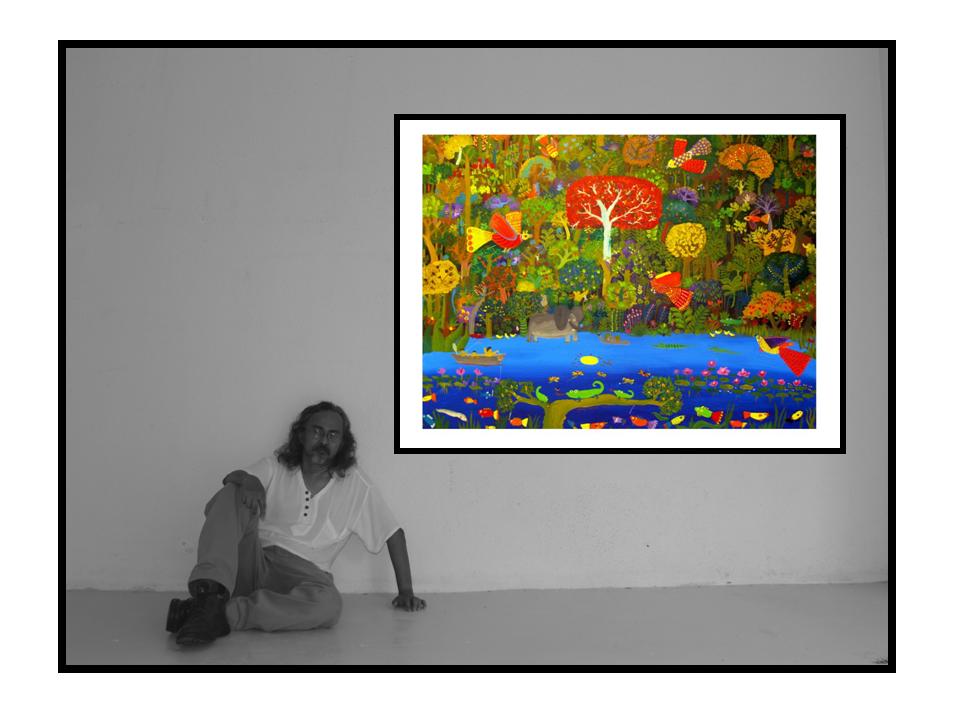Standing before Yusof Gajah painting, with its tiny intricate landscapes and swarms of diminutive wildlife, one feels like Gulliver among the Liliputians. Yet the painting depict land both strange and familiar, because-despite its exaggerated “fiesta” palette of ludicrous colour and overblown sense of design-Yusof’s landscape meticulously parodies and even replicates real issues in a real world.
From the first moment the viewer is captivated, he becomes preoccupied with the search of deeper meaning and, suddenly, concern for the environment, for sovereignty of Nature and for the place of progress within that scenario comes to the fore. The newest series from his Insect Series incorporate displaced skyscrapers within Nature’s scheme of things. These painting reveal the artist’s interest in contemporary events as well as his lifelong fascination with Nature and Man placed in it.
Born in Johol, a small village in Negeri Sembilan, Yusof Ismail, 45, grew up surrounded by the vibrant beauty of Nature. “But not for long. My father was with the Police and he was transferred to
His early years are represented by one of the only remaining oils painted in 1971-a classical landscape of Padi planter with kerbau –in a dramatic play of light and shadows…a work the artist describes as his “tribute to Hoessien Enas.” A three stint in
After a few months, Yusof decided to switch to art and enrolled in the Sekolah Seni Rupa
It would also be at one of the Anak Alam shows in the mid-70s that Yusof Ismail would find himself. Reacting to Yusof’s painting of a quartet of elephants, the show’s catalogue writer, Johan Jaafar. Poignantly described the young artist as having beberapa ekor gajah sedang menjerit dalam otaknya ( a few elephants shouting in his head). It has been Yusof Gajah ever since!
The roots of Yusof Gajah current paintings come from more than two decades of exploring naïve art not only for art’s sake but also for its story telling possibilities. An accomplished children’s book illustrator, Yusof has won several prestigious awards including the 1997 Grand Prix awards at Noma Concours for Children’s Picture Book Illustration in
It is a gift for telling a story that has dictated his series of works, from the early linear series to his gouache landscape, his acrylic Siri Pemandangan and his elephant paintings culminating in his Siri Gajah-Gajah. He sees elephants everywhere. Give him a leaf and he will read an elephant in it. Yusof’s mischievous wit is frequently apparent in the activity of the players in his luscious landscapes… alligators swim transparent across the picture plane, fantastical birds in resplendent yellows and red front the skies like elaborate wau which have escaped their tethers and elephants peek out from flora and fauna.
“People are always looking for my elephants even they are not there,” he laughs. “So I have to slip them in; sometimes when don’t include them I just say they are swimming underwater.” The most recent works, whether in watercolour or acrylic, show the artist in heightened wit, exploring the character of 20, 30, 100 pachyderms as if they were the alphabet. The new watercolour, which the artist describes as ‘studies’ or “sketches”, have delightful design of quality about them, while the acrylic elephants posses a gestural spontaneity of paint and texture that is all fine art and far remove from the realms of illustration.
The two elements that have prevailed in his own sense of humour and his special fascination for a naïve expression. However, Yusof himself is uncomfortable with the misconceptions that arise with the word “naïve.”
“Too many people tend to associate it with being unschooled or to be lacking in ability. They cannot understand that the need to exaggerate scale, features or colour is intentional, a way of expressing or heightening a sentiment.” Naïve art or NAIF art refers to the artists in so called sophisticated societies who reject conventional expertise in the representation or expression of real object. They should not be confused with Sunday Painters or Hobbyist who paint for fun.
Instead, an artist like Yusof creates with the same passion as any artist of any other ‘ism’, except that he makes that conscious effort to disregard a formal knowledge of method. He rejects subtle mixtures and tones and careful composition for brilliant, saturated colour and chaotic detail-an absence of perspective resulting in the two dimensionality of the picture plane. This effect is further enhanced by the method of work which consists of painting each picture plane completely from the back to fore-the animals and birds painted as the last layer. Yusof also unimpressed by the current preoccupation that the artist seems to have with the “Asian-ness” of their works. “Art is the universal language. While some people claim that naïve movement evolved from American folk art traditions that is too limiting. Asian art is rife with ‘naïve’ depiction’: Indonesian painting boasts this tradition, regional weaving possesses elements of it. Who is to say that it not relevant?”
Sometimes his observation or critical commentary are clear, like in the more recent works where monkeys and lizards abound in the wake of unforgiving skyscrapers. Mostly the imagery verges on esoteric and appear to be some private joke of the artist. In his paintings, a sense of stability and continuity is suggested in the precise and carefully ordered compositions, and the bright, bold colours lend a note of optimism that Nature will prevail. But this may only be illusion for many of his characters, in all their naïveté, remain fantastical as if they are already extinct. Childlike delight tinged with a kind of poignant nostalgia prevails-for all of us.
.jpg)

0 comments:
Post a Comment